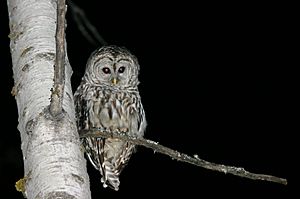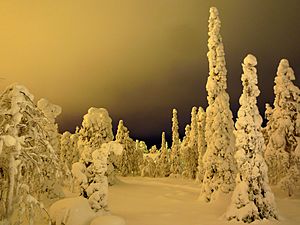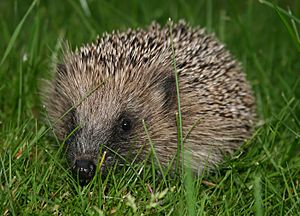Nocturnality facts for kids
Nocturnality is when an animal is active at night and sleeps during the day. Animals that do this are called nocturnal. The opposite is being diurnal, which means being active during the day.
Nocturnal animals often have super sharp senses of hearing and smell. Their eyesight is also specially made for the dark. Some animals, like cats and ferrets, can see well both in dim light and bright daylight. Others, such as bushbabies and some bats, can only really get around at night.
Many nocturnal creatures, like tarsiers and certain owls, have very large eyes. This helps them see better when there isn't much light. Their eyes have a bigger cornea (the clear front part of the eye) compared to animals active in the day. This helps them be more sensitive to light. Being nocturnal also helps some wasps avoid hunting when the sun is too strong.
Animals that are active during the day include humans, squirrels, and songbirds. Some animals are called crepuscular. This means they are most active at dawn (sunrise) and dusk (sunset). Examples include rabbits, skunks, tigers, and hyenas. Animals like fossas and lions are cathemeral, meaning they can be active both day and night.
Contents
Why Animals Are Nocturnal

Scientists believe that being nocturnal might have helped early mammals survive. A theory called the "nocturnal bottleneck" suggests that millions of years ago, many ancestors of today's mammals became nocturnal. This was to avoid being eaten by the many diurnal (daytime) predators around at that time.
Even today, many mammals still have traits from their nocturnal past. For example, they might have a great sense of smell or amazing hearing. These senses help them even if they are not active at night anymore. Studies on ancient birds like the elephant bird and modern kiwi birds show they had large olfactory bulbs (for smell) and smaller optic lobes (for sight). This suggests their ancestors were nocturnal, relying more on smell than sight.
Finding Food and Avoiding Competition
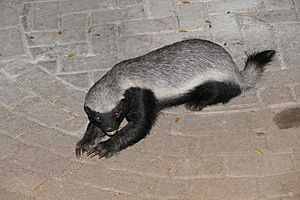
Being active at night is a clever way for animals to share resources. Imagine a field where both hawks and owls hunt for the same small animals. They don't fight over food because hawks hunt during the day, and owls hunt at night. This means they are not competing with each other for the same prey.
Nocturnality also helps with pollination. Moths, beetles, and bats are nocturnal pollinators. They are less likely to be seen by predators at night. Some plants even release their scents and warmth at night to attract these nighttime helpers.
Staying Safe from Predators
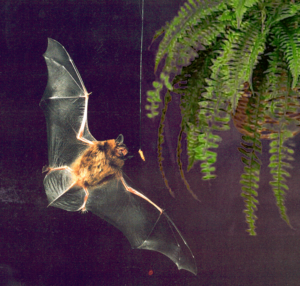
Being nocturnal can also be a way to hide from predators. Many animals that hunt during the day have poor night vision. For example, lions often hunt at night because animals like zebras and wildebeest can't see well in the dark.
Many small rodents, like the Large Japanese field mouse, are active at night. This is because most of the birds that hunt them are active during the day. Some daytime animals also act nocturnal at times. For instance, many seabirds and sea turtles only gather at their breeding spots at night. This helps protect themselves and their babies from predators.
Nocturnal animals can also hunt prey that are used to avoiding daytime predators. Some nocturnal fish use moonlight to find tiny creatures called zooplankton that come to the surface at night. Animals like bats have special skills, such as echolocation. They use sound waves to find their prey in the dark.
Saving Water
Another big reason for being nocturnal is to avoid the heat. This is especially true in hot, dry places like deserts. By being active at night, animals don't lose as much water from their bodies. This helps them stay hydrated. For example, Hamiltons Frog stays hidden during the hot day and comes out at night when it's cooler and more humid.
Many desert plants also have flowers that open only at night. This protects their delicate blossoms from the sun's heat. These flowers are often pollinated by bats.
Because of climate change and rising temperatures, some animals that used to be active during the day are now becoming more active at dawn, dusk, or even at night. This helps them avoid the hottest parts of the day without having to leave their homes.
How Humans Affect Nocturnal Animals
The way humans have grown and developed technology has a big impact on nocturnal animals. Two main reasons for this are light pollution and changes to their habitats.
Light Pollution
Light pollution is a big problem for animals that rely on darkness. As more places get electricity, the problem grows. Animals in tropical areas are often affected more because their natural light patterns are very steady. Animals in other areas also suffer if their natural day-night cycles are disturbed.
Some daytime predators actually benefit from more light. They get a "longer day" to hunt, which is bad news for their nocturnal prey trying to hide.
Getting Lost
Artificial lights can confuse animals that are used to darkness. Insects are a clear example; they are drawn to lights and often die from the heat or electricity. Some frogs can be blinded by sudden bright lights. Nocturnal birds that migrate might get lost, get tired, or become easy targets for predators.
Sea turtles are especially affected. Adult turtles might avoid bright beaches where they would normally lay eggs. Baby sea turtles that hatch on lit beaches often get confused. Instead of heading towards the ocean, they go towards the artificial lights and get lost.
Daily and Seasonal Rhythms
Light pollution can mess up animals' daily and seasonal routines. For example, migrating birds or mammals might have trouble knowing when to start their journeys. On a daily basis, animals can experience changes in their body temperature, movement, feeding habits, and even body weight. These small changes can eventually lead to fewer animals in a population. They can also harm the balance of nature. Some animals that are usually active during the day have even started to become active at night because of light pollution and human activity.
Reproduction
Light pollution can also affect how animals reproduce. It can change how they choose mates, when they travel to breeding areas, and where they build their nests. For example, male green frogs call less for mates when there's artificial light. This makes it harder for them to find a partner, which is a concern as frog populations are already decreasing.
Hunting and Being Hunted
Artificial light can also disrupt how nocturnal predators and prey interact. Fast-flying bats might have an advantage when insects are drawn to lights. They can escape predators that are also attracted to the light. But slower bats are at a disadvantage. Another example is harbor seals eating young salmon in a river lit by nearby artificial lights. When the lights were turned off, fewer salmon were eaten. Many daytime prey animals that are forced to be active at night become easy targets for nocturnal predators, especially if they can't see well in the dark.
Changes to Habitats
As humans expand and build more, animal habitats are destroyed or changed. This has both good and bad effects on nocturnal animals. Since humans are most active during the day, some animals become more active at night to avoid people.
However, meat-eating predators are often less afraid of human activity. They might even eat human waste. This means they often stay in the same areas as before. But plant-eating prey animals tend to stay in areas where there are fewer humans. This limits their food and living space. This can lead to more predators and fewer prey animals, which can upset the natural balance.
Nocturnal Animals and People
In Zoos
Zoos often have special "night-illumination enclosures" for nocturnal animals. These enclosures reverse the animals' normal sleep-wake cycle. This means the animals are active when visitors are there to see them.
As Pets
Hedgehogs and sugar gliders are two examples of nocturnal animals kept as pets. Cats are very adaptable. A stray cat or a pampered housecat can change when they are active. They can become nocturnal or diurnal depending on their surroundings or their owners' routines. Cats are naturally crepuscular, meaning they are most active at dawn and dusk for hunting and exploring.
See also
 In Spanish: Nocturnidad para niños
In Spanish: Nocturnidad para niños
- Adaptation
- Antipredator adaptation
- Competitive exclusion principle
- Crepuscular
- Crypsis
- Diurnality
- List of nocturnal animals
- List of nocturnal birds
- Niche (ecology)
- Niche differentiation
- Night owl (person)


